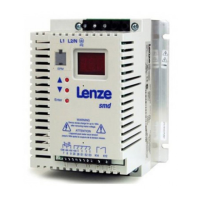How to fix communication error on Lenze ESMD302L4TXA?
- SstaceymurphySep 1, 2025
If the Lenze Inverter reports a communication error, it could be due to the serial timer timing out. In this case, check the serial link connections.

How to fix communication error on Lenze ESMD302L4TXA?
If the Lenze Inverter reports a communication error, it could be due to the serial timer timing out. In this case, check the serial link connections.
What does external error mean on Lenze Inverter?
If the Lenze Inverter displays 'External error', it means the digital input “TRIP set” is active. To resolve this, remove the external error.
What causes motor overload on Lenze ESMD302L4TXA?
If the Lenze Inverter displays a motor overload (I2t overload), it means the motor is thermally overloaded. This can be due to: * Impermissible continuous current. * Frequent or excessively long acceleration processes. To resolve this: * Check the controller selection. * Check the setting of c20.
What does it mean when Lenze DC Drives reach the current limit?
Reaching the current limit in Lenze DC Drives indicates a controllable overload, which is managed automatically.
What causes overvoltage on DC bus in Lenze DC Drives and how to fix it?
Overvoltage on the DC bus in Lenze DC Drives can be caused by several factors. It may be due to mains voltage being too high, so you should check the mains voltage. Another cause can be an excessively short deceleration time or the motor operating in generator mode; in this case, increase the deceleration time or use a dynamic braking option. Finally, earth leakage on the motor side can also cause this issue, so check the motor and motor cable, separating the motor from the controller.
What to do if Lenze DC Drives show data on EPM not valid?
If Lenze DC Drives indicate that the data on the EPM is not valid, it means the data is not valid for the controller. Use an EPM providing valid data or load the Lenze setting.
What causes automatic start to be inhibited in Lenze DC Drives?
If automatic start is inhibited in Lenze DC Drives, it is because c42 = 0. You should apply a LOW-HIGH signal change at terminal 28.
How to resolve dynamic braking fault in Lenze DC Drives?
A dynamic braking fault in Lenze DC Drives typically means that the dynamic braking resistors are overheating. To resolve this, increase the deceleration time.
What to do if Lenze DC Drives show undervoltage on DC bus?
If Lenze DC Drives show undervoltage on the DC bus, it could be because the mains voltage is too low. Check the mains voltage.
What to do if Lenze DC Drives have controller overtemperature?
If the controller has an overtemperature, it means the controller is too hot inside. To resolve this, reduce the controller load and improve cooling.
| Input Voltage | 380-480VAC |
|---|---|
| Input Frequency | 47-63 Hz |
| Output Frequency | 0-500 Hz |
| Rated Power | 3.0 kW |
| Protection Class | IP20 |
| Type | Inverter |
| Output Voltage | 0-Input Voltage |
| Output Current | 7 A |
| Control Method | V/f control |
| Cooling Method | Air cooling |
| Communication Interface | RS485 |
| Operating Temperature | -10°C to +50°C |
General introduction to the documentation and safety aspects.
Covers general precautions, electrical hazards, application, installation, and operation safety.
Explains safety pictograms and provides specific notes for UL systems.
Specifies conformity, approvals, and environmental conditions for operation.
Details power, voltage, current, and frequency ratings for various models.
Covers dimensions, mounting, and environmental considerations for installation.
Guidelines for electrical installation, wiring, fuses, and EMC compliance.
Illustrates connection points and provides instructions for long-term storage.
Describes the function and configuration of various control terminals.
Overview of setting parameters via keypad and EPM.
Functionality and use of the EPM for parameter storage.
Covers essential parameters for settings, inputs, outputs, and motor control.
Configuration for serial communication, fault handling, and advanced settings.
Lists operational statuses, causes of faults, and basic remedies.
Detailed explanations of error codes, their causes, and corrective actions.











